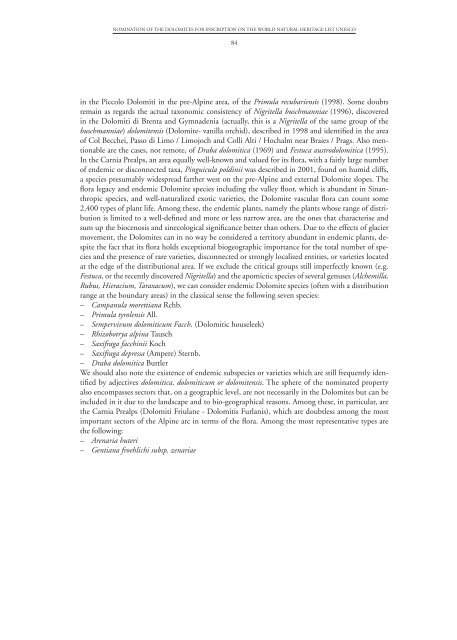DOLOMITES - Annexes 2-8 - Provincia di Udine
DOLOMITES - Annexes 2-8 - Provincia di Udine
DOLOMITES - Annexes 2-8 - Provincia di Udine
You also want an ePaper? Increase the reach of your titles
YUMPU automatically turns print PDFs into web optimized ePapers that Google loves.
NOMINATION OF THE <strong>DOLOMITES</strong> FOR INSCRIPTION ON THE WORLD NATURAL HERITAGE LIST UNESCO<br />
84<br />
in the Piccolo Dolomiti in the pre-Alpine area, of the Primula recubariensis (1998). Some doubts<br />
remain as regards the actual taxonomic consistency of Nigritella buschmanniae (1996), <strong>di</strong>scovered<br />
in the Dolomiti <strong>di</strong> Brenta and Gymnadenia (actually, this is a Nigritella of the same group of the<br />
buschmanniae) dolomitensis (Dolomite- vanilla orchid), described in 1998 and identified in the area<br />
of Col Becchei, Passo <strong>di</strong> Limo / Limojoch and Colli Alti / Hochalm near Braies / Prags. Also mentionable<br />
are the cases, not remote, of Draba dolomitica (1969) and Festuca austrodolomitica (1995).<br />
In the Carnia Prealps, an area equally well-known and valued for its flora, with a fairly large number<br />
of endemic or <strong>di</strong>sconnected taxa, Pinguicula pol<strong>di</strong>nii was described in 2001, found on humid cliffs,<br />
a species presumably widespread farther west on the pre-Alpine and external Dolomite slopes. The<br />
flora legacy and endemic Dolomite species inclu<strong>di</strong>ng the valley floor, which is abundant in Sinanthropic<br />
species, and well-naturalized exotic varieties, the Dolomite vascular flora can count some<br />
2,400 types of plant life. Among these, the endemic plants, namely the plants whose range of <strong>di</strong>stribution<br />
is limited to a well-defined and more or less narrow area, are the ones that characterise and<br />
sum up the biocenosis and sinecological significance better than others. Due to the effects of glacier<br />
movement, the Dolomites can in no way be considered a territory abundant in endemic plants, despite<br />
the fact that its flora holds exceptional biogeographic importance for the total number of species<br />
and the presence of rare varieties, <strong>di</strong>sconnected or strongly localized entities, or varieties located<br />
at the edge of the <strong>di</strong>stributional area. If we exclude the critical groups still imperfectly known (e.g.<br />
Festuca, or the recently <strong>di</strong>scovered Nigritella) and the apomictic species of several genuses (Alchemilla,<br />
Rubus, Hieracium, Taraxacum), we can consider endemic Dolomite species (often with a <strong>di</strong>stribution<br />
range at the boundary areas) in the classical sense the following seven species:<br />
– Campanula morettiana Rchb.<br />
– Primula tyrolensis All.<br />
– Sempervivum dolomiticum Facch. (Dolomitic houseleek)<br />
– Rhizobotrya alpina Tausch<br />
– Saxifraga facchinii Koch<br />
– Saxifraga depressa (Ampere) Sternb.<br />
– Draba dolomitica Buttler<br />
We should also note the existence of endemic subspecies or varieties which are still frequently identified<br />
by adjectives dolomitica, dolomiticum or dolomitensis. The sphere of the nominated property<br />
also encompasses sectors that, on a geographic level, are not necessarily in the Dolomites but can be<br />
included in it due to the landscape and to bio-geographical reasons. Among these, in particular, are<br />
the Carnia Prealps (Dolomiti Friulane - Dolomitis Furlanis), which are doubtless among the most<br />
important sectors of the Alpine arc in terms of the flora. Among the most representative types are<br />
the following:<br />
– Arenaria huteri<br />
– Gentiana froehlichi subsp. zenariae

















